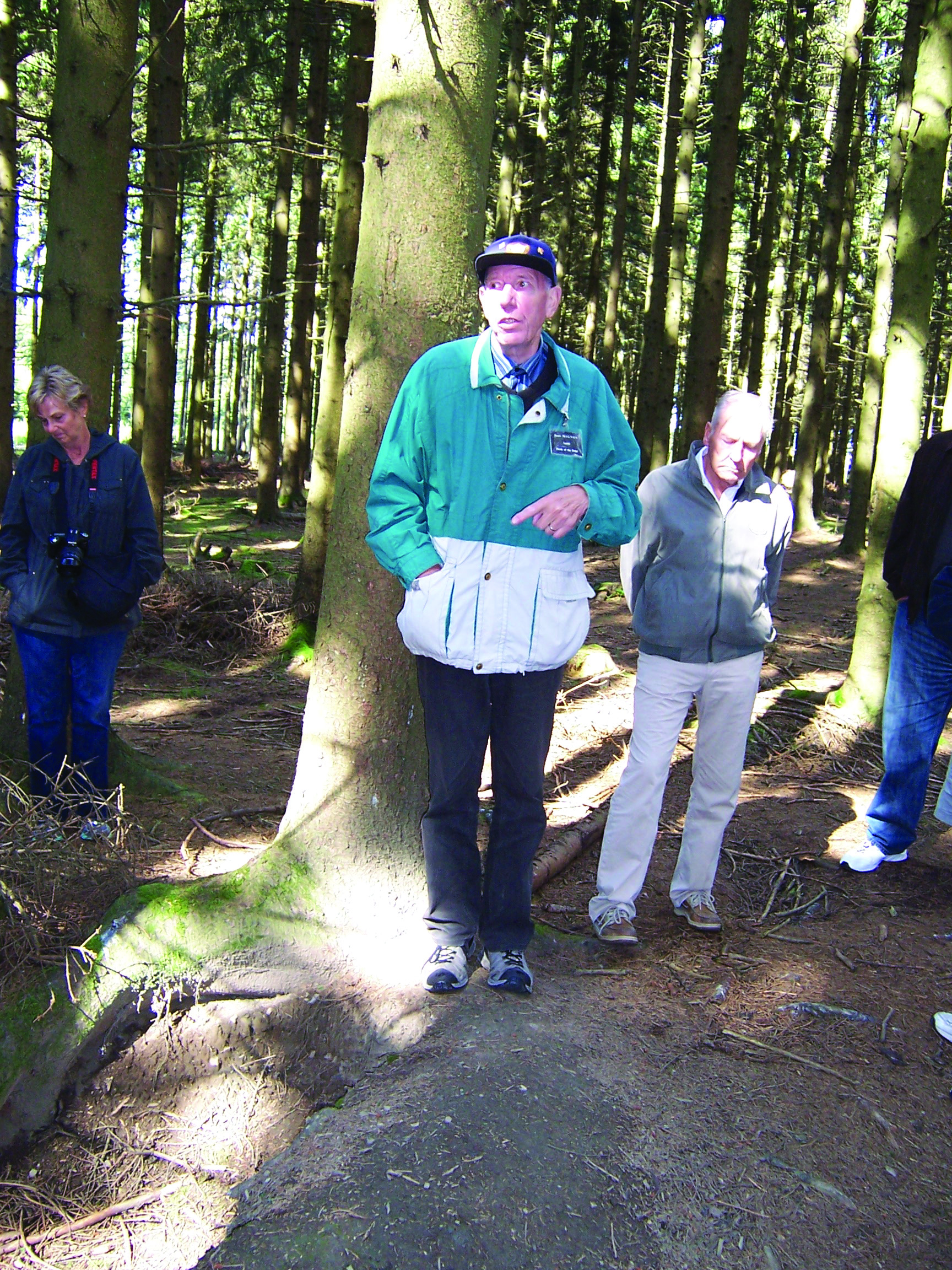Ken Beaton and Lin Nary enjoy lunch at Le Nuts restaurant in the center of Bastogne, Belgium, on Sept. 26, 2011.
Can you name any of the 36 U.S. Army divisions that valiantly fought in the Battle of the Bulge 80 years ago? Did you mention the “Screaming Eagles,” the 101st Airborne Division, the “The Golden Talons,” the 17th Airborne or the “All American,” the 82nd Airborne? You earned partial credit for your answer.
If you answered 22 infantry, 11 armored and three airborne divisions for a total of 36 U.S. Army divisions, you win. The “Battling Bastards of Bastogne” were the 17th and the 101st Airborne divisions with the 10th Combat Brigade (3,000 men with 60 of the newest Sherman tanks, M4A1E6, that included 76mm and 36 tank destroyers) along with a few GIs stragglers.
The soldiers defended the seven crossroads in Bastogne, Belgium. What most people don’t know is on Dec. 16, 1944, Gen. Dwight Eisenhower decided to send his three best divisions to stop the advancing German armies. The 82nd Airborne Division was assigned the northern sector of the bulge, the Vielsalm-St. Vith region with the 101st and the 17th assigned to Bastogne, south of the 82nd. This was a strategic move similar to a championship chess game.
In less than 40 hours, the entire 82nd division traveled 150 miles by truck from Reims in France to its combat assignment, yet they arrived late on Dec. 17. They dug in and stopped the Germans’ SS Divisions. Every GI who supported our fighting troops, cooks, supply clerks, headquarters personnel and truck drivers including African American GIs was issued a weapon and rushed to the front. The soldiers of the 82nd fought bravely with rifles, grenades and bayonets.
Our GIs were outnumbered by Germany’s Gen. Von Runstedt’s best troops with the Obersturmbannführer (lieutenant colonel) Joachim Peiper and the new Tiger II tanks at the point of attack. Tiger II tanks had up to eight inches of armor at the point.
Our bazooka teams had to hit a Tiger on the side near the front track wheels to disable it. As soon as the top hatch opened, a soldier would pull the pin on a phosphorus grenade, toss it inside the tank and the hatch. The burning phosphorus from the grenade would cause the 88 shells in the Tiger II to detonate
It was Obersturmbannführer Peiper who captured 113 American engineers at Malmedy, Belgium. He ordered the American prisoners to be machine gunned with the Germans murdering 84 of them and leaving their bodies to freeze in the snow on Dec. 17. The killing of our 84 soldiers spread like wildfire among the 600,000 GIs at the front who vowed, “Don’t take any Kraut prisoners!”
The commanding officer of the 291st Engineer Combat Battalion, Lt. Col. David Pelgrim, oversaw 600 men with the average age of 19, and another 32 officers. They stopped Peiper dead in his tracks at Habiemont by blowing the only bridge just as his first tank was about to cross.
How do you dig a fox hole during the coldest European winter in over 20 years with blizzard conditions? Answer — a couple of hand grenades were effective. A fox hole was the soldier’s barracks, mess hall, sleeping quarters and pit toilet. Nobody wanted to be shot.

Courtesy of Ken Beaton
The man with the ball cap was our Bastogne guide and a Belgian. He was an 8-year-old boy in December 1944 when his dad was killed by a German artillery shell.
There were two GIs per fox hole, and soldiers changed their socks four times a day to prevent trench foot. They also took turns sleeping at night and kept each other warm by sharing body heat. Our GIs were continuously in blizzard conditions and up to waist-deep snow for days. A favorite expression of our 101st troopers was, “They have us surrounded, poor bastards.”
The Black GIs fought bravely during the Battle of the Bulge to impress the “Brass” — the American generals. Their efforts were finally rewarded three years after the war on July 26, 1948, when President Truman signed Executive Order 9981 ending segregation in the military.
The Battle of the Bulge was the largest battle during the war from Dec. 16, 1944, to Jan. 31, 1945. Approximately 610,000 American GIs fought during the month-and-a-half. The U.S. had 89,000 causalities, which resulted in about 19,000 telegrams sent to parents/spouses: “The Secretary of the War regrets the loss of your son/husband.”
Thousands of families and tens of thousands of friends grieved. The 19,000 new gold stars replaced the blue stars that were proudly displayed in a front window in the U.S. A gold star was the symbol for the loss of a relative during the war.
Since 1945 on the second Saturday in December, the mayor of Bastogne and any notable guest or two toss nuts to the crowd below in the square. They celebrate Gen. Anthony Clement McAuliffe’s famous one-word answer to the Germans regarding their surrender demand. He replied “Nuts.”
Dec. 16 is the 80th anniversary of the first day of the Battle of the Bulge.
Thank a veteran by firmly shaking their hand and telling them in a firm voice while maintaining eye contact, “Thank you for your service. I speak English today — not German — because of you and everyone who served.”